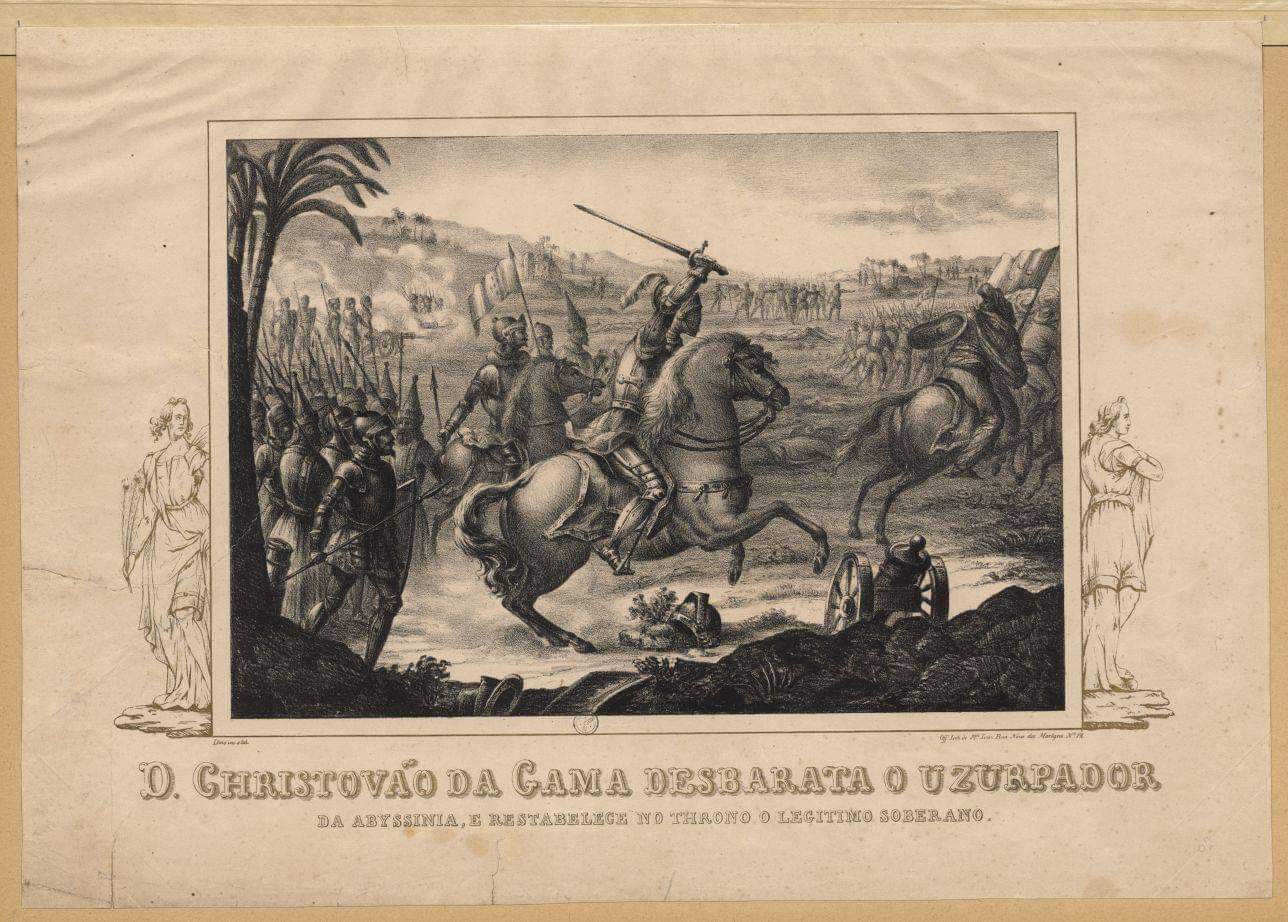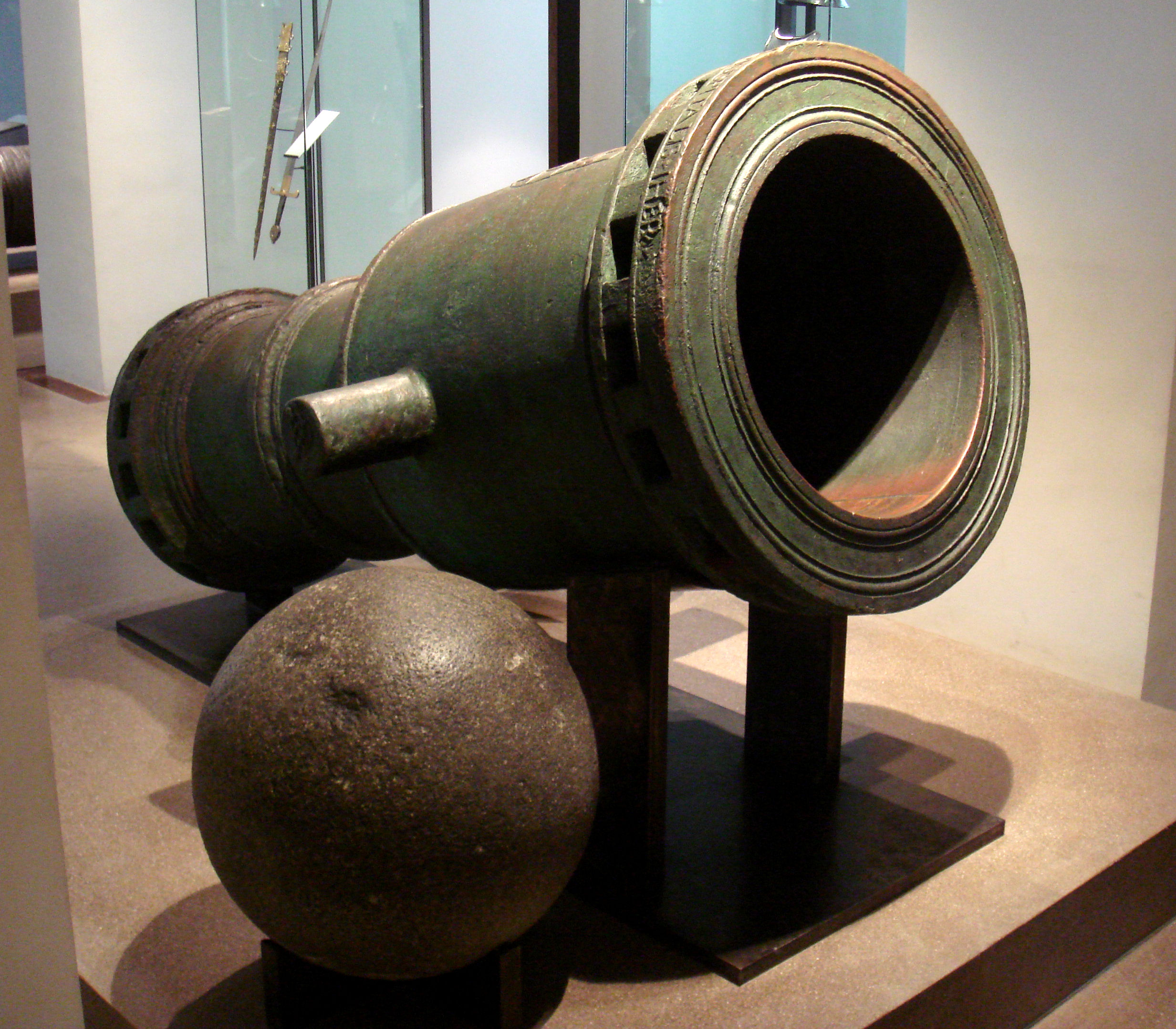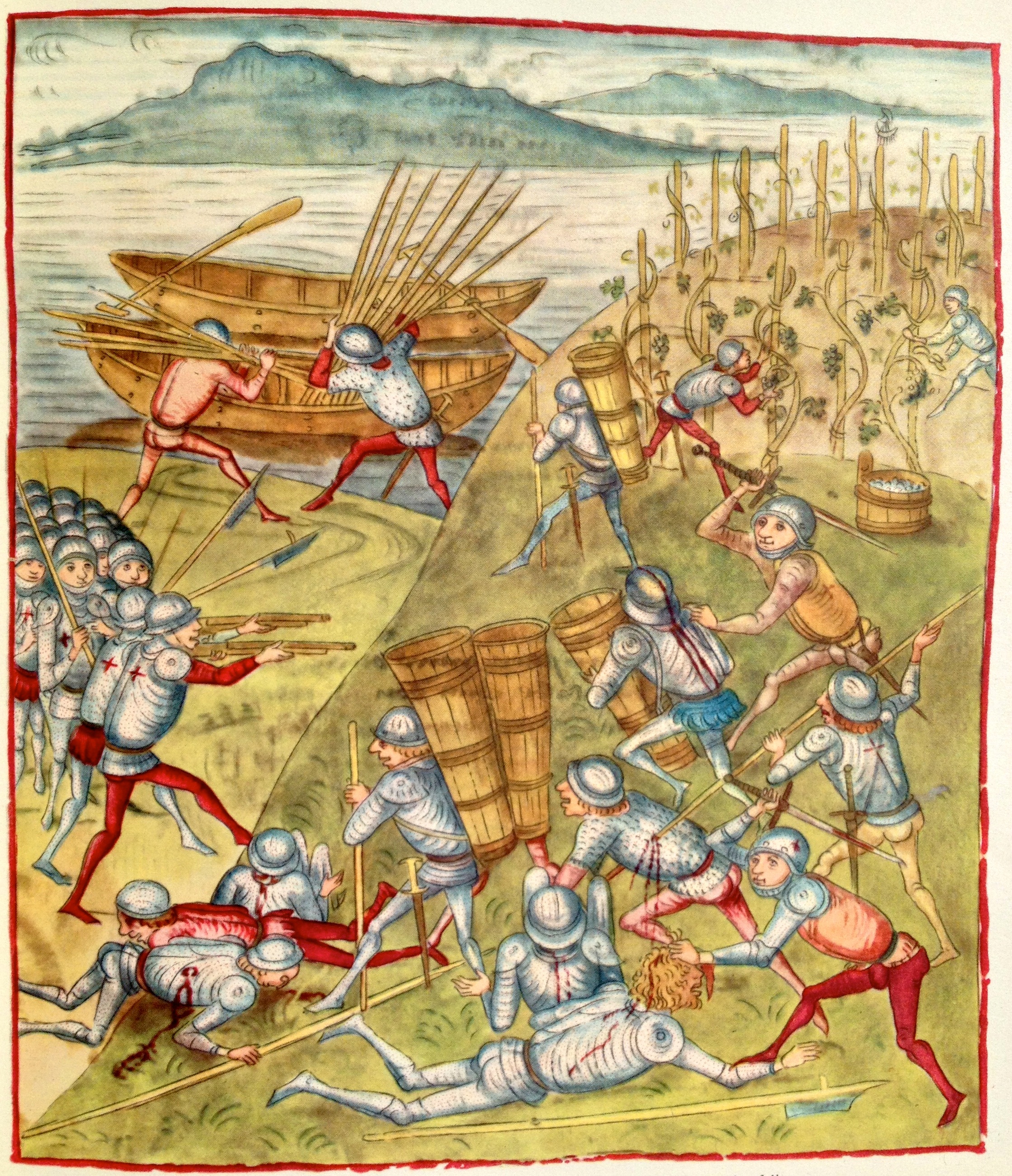|
Cristóvão Da Gama
Cristóvão da Gama ( 1516 – 29 August 1542), anglicised as Christopher da Gama, was a Portugal, Portuguese military commander who led a Portuguese army of 400 musketeers to assist Ethiopia that faced Islamic Jihad from the Adal Sultanate led by Imam Ahmad ibn Ibrahim al-Ghazi. He, along with the allied Ethiopian army, was victorious against Adal forces in four battles, but he was seriously wounded in his last Battle of Wofla, battle and was captured, tortured, and executed by Imam Ahmad ibn Ibrahim al-Ghazi, Ahmad. Richard Francis Burton, Richard Burton, in his ''First Footsteps in East Africa'', referred to Gama as "the most chivalrous soldier of a chivalrous age". Early career Cristóvão (or Christopher) da Gama was the son of navigator Vasco da Gama and the younger brother of Estêvão da Gama (16th century), Estêvão da Gama. He first went to India in 1532 with his brother, returned to Portugal in 1535, and then joined Garcia de Noronha in sailing to Daman and Diu, Di ... [...More Info...] [...Related Items...] OR: [Wikipedia] [Google] [Baidu] |
Padrão Dos Descobrimentos
A ''padrão'' (literally "standard") (, ''flag, standard''; plural: ) is a stone pillar left by Portuguese maritime explorers in the 15th and 16th centuries to record significant landfalls and thereby establish primacy and possession. They were often placed on promontories and capes or at the mouths of major rivers. Early markers were simple wooden pillars or crosses but they deteriorated quickly in the tropical climate where they were often erected. Later, ''padrões'' were carved from stone in the form of a pillar surmounted by a cross and the coat of arms of Portugal, royal coat of arms. History Diogo Cão was the first to place stone padrões on his voyage of discovery along the coast of Africa in 1482–1484. They had been carved ahead of time in Portugal and carried in his ship at the behest of John II of Portugal, King João II. Cão placed the pillars at points in what is now Gabon, Angola and Namibia. The first was installed at the mouth of the river Congo. In August 148 ... [...More Info...] [...Related Items...] OR: [Wikipedia] [Google] [Baidu] |
Daman And Diu
Daman and Diu (; ) was a union territory in northwestern India. With an area of , it was the smallest administrative subdivision of India on the mainland. The territory comprised two districts, Daman and Diu Island, geographically separated by the Gulf of Khambat. The state of Gujarat and the Arabian Sea bordered the territory. A Portuguese colony since the 1500s, these territories were taken over by India with the Annexation of Goa in 1961. Daman and Diu were administered as part of the union territory of Goa, Daman and Diu between 1961 and 1987. After the Goa Opinion Poll, they became separate union territories. In 2019, a legislation was passed to merge the union territories of Daman and Diu with its neighbouring union territory, Dadra and Nagar Haveli, to form the new union territory of Dadra and Nagar Haveli and Daman and Diu with effect from 26 January 2020. History For over 450 years, the coastal enclaves of Daman ( Portuguese: Damão) and Diu on the Arabian Sea c ... [...More Info...] [...Related Items...] OR: [Wikipedia] [Google] [Baidu] |
Latin Patriarchate Of Ethiopia
The Latin Patriarchate of Ethiopia was a Latin patriarchal see of the Catholic Church in Ethiopia from 1555 to 1663. The archbishopric was held primarily by Portuguese bishops and all members of the Society of Jesus. List of Latin Patriarchs of Ethiopia *''Uncanonical: João Bermudes (1536? – 1545?; died 1570) * João Nunes Barreto, S.J. (1555.01 – retired 1557) * Andrés de Oviedo, S.J. (Spanish; 1562.12.22 – death 1577.06.29), succeeding as former Coadjutor Archbishop of Ethiopia (Ethiopia) (1555.01.23 – 1562.12.22) & Titular Archbishop of Hierapolis in Syria of the Syrians (1555.01.23 – 1577.06.29) * Melchior Carneiro (賈耐勞), S.J. (1577 – retired 1581), previously Titular Archbishop of Nicæa (1555.01.23 – 1577) & Auxiliary Bishop of Ethiopia (Ethiopia) (1555.01.23 – 1577); also Apostolic Administrator of Macau 澳門 (Macau, Portuguese China) (1576.01.23 – 1581) * Afonso Mendes, S.J. (1622.12.19 – retired 1636) Non-succeeding Coadjutor ... [...More Info...] [...Related Items...] OR: [Wikipedia] [Google] [Baidu] |
Gaspar Correia
Gaspar Correia (1492 – c. 1563 in Goa) was a Portuguese historian who wrote ''Lendas da Índia'' (Legends of India), one of the earliest and most important works about Portuguese rule in Asia.Ana Paula Avelar, "Gorreia, Gaspar" , in CHAM Letra Biography  Little is known of the author or his family origins and birthplace. It is assumed that he was born in 1492. He lived mostly in , reportedly arriving around 1 ...
Little is known of the author or his family origins and birthplace. It is assumed that he was born in 1492. He lived mostly in , reportedly arriving around 1 ...
[...More Info...] [...Related Items...] OR: [Wikipedia] [Google] [Baidu] |
Bombard (weapon)
The bombard is a type of cannon or mortar which was used throughout the Late Middle Ages and the early modern period. Bombards were mainly large calibre, muzzle-loading artillery pieces used during sieges to shoot round stone projectiles at the walls of enemy fortifications, enabling troops to break in. Most bombards were made of iron and used gunpowder to launch the projectiles. There are many examples of bombards, including Mons Meg, the Basilic, the Dardanelles Gun, and the handheld bombard. The weapon provided the name to the Royal Artillery rank of bombardier and the word 'bombardment'. Terminology The term "bombard" was first used to describe guns of any kind from the early to mid-14th century, but it was later applied primarily to large cannons during the 14th to 15th centuries. Despite its strong association with large cannons, there is no standard size for bombards, and the term has been applied to cannons only a meter in length as well as cannons several meters ... [...More Info...] [...Related Items...] OR: [Wikipedia] [Google] [Baidu] |
Pike (weapon)
A pike is a long thrusting spear formerly used in European warfare from the Late Middle Ages and most of the early modern warfare, early modern period, and wielded by infantry, foot soldiers deployed in pike square formation, until it was largely replaced by bayonet-equipped muskets. The pike was particularly well known as the primary weapon of Spanish tercios, Swiss mercenary, German Landsknecht units and French sans-culottes. A similar weapon, the sarissa, had been used in classical antiquity, antiquity by Alexander the Great's Ancient Macedonians, Macedonian phalanx infantry. Design The pike was a long weapon, varying considerably in size, from long. Generally, a spear becomes a pike when it is too long to be wielded with one hand in combat. It was approximately in weight, with the 16th-century military writer John Smith (High Sheriff of Kent), Sir John Smythe recommending lighter rather than heavier pikes. It had a wooden shaft with an iron or steel spearhead affixed. Th ... [...More Info...] [...Related Items...] OR: [Wikipedia] [Google] [Baidu] |
Arquebus
An arquebus ( ) is a form of long gun that appeared in Europe and the Ottoman Empire during the 15th century. An infantryman armed with an arquebus is called an arquebusier. The term ''arquebus'' was applied to many different forms of firearms from the 15th to 17th centuries, but it originally referred to "a hand cannon, hand-gun with a hook-like projection or lug on its under surface, useful for steadying it against battlements or other objects when firing". These "hook guns" were in their earliest forms defensive weapons mounted on German city walls in the early 15th century. The addition of a shoulder stock, priming pan, and matchlock mechanism in the late 15th century turned the arquebus into a handheld firearm and also the first firearm equipped with a trigger. The exact dating of the matchlock's appearance is disputed. It could have appeared in the Ottoman Empire as early as 1465 and in Europe a little before 1475. The heavy arquebus, which was then called a musket, was d ... [...More Info...] [...Related Items...] OR: [Wikipedia] [Google] [Baidu] |
Gelawdewos Of Ethiopia
Galawdewos (, 1521/1522 – 23 March 1559), also known as Mar Gelawdewos (), was Emperor of Ethiopia from 3 September 1540 until his death in 1559, and a member of the Solomonic dynasty. His throne name was Atsnaph Sagad I (Ge'ez: አጽናፍ ሰገድ). A male line descendant of medieval Amhara kings, he was a younger son of Dawit II and Seble Wongel. Early reign The son of Dawit II by his wife, Seble Wongel, after the death of his father Gelawdewos succeeded to the throne on 2 September 1540 at the age of 18. During Ahmed Gragn's occupation of Abyssinia, Galawdewos initially took refuge in the province of Gafat. Despite his youth, over the next few months he made several successful attacks on the Adalite garrisons in northern Ethiopia. At the time of the Portuguese arrival in Ethiopia, Gelawdewos was in northern Shewa leading a small guerrilla movement against the Muslim occupation. When he heard of the Portuguese arrival he marched northward to join them but the Por ... [...More Info...] [...Related Items...] OR: [Wikipedia] [Google] [Baidu] |
Emperor Of Ethiopia
The emperor of Ethiopia (, "King of Kings"), also known as the Atse (, "emperor"), was the hereditary monarchy, hereditary ruler of the Ethiopian Empire, from at least the 13th century until the abolition of the monarchy in 1975. The emperor was the head of state and head of government, with ultimate executive power, executive, judicial power, judicial and legislative power in that country. A ''National Geographic'' article from 1965 called Imperial Ethiopia "nominally a constitutional monarchy; in fact it was a benevolent dictatorship, benevolent autocracy". Title and style The title "King of Kings", often rendered imprecisely in English as "emperor", dates back to ancient Mesopotamia, but was used in Aksumite Empire, Axum by King Sembrouthes (). However, Yuri Kobishchanov dates this usage to the period following the Persian Empire, Persian victory over the Roman Empire, Romans in 296–297. The most notable pre-Solomonic usage of the title "Negusa Nagast" was by Ezana of Ax ... [...More Info...] [...Related Items...] OR: [Wikipedia] [Google] [Baidu] |
Massawa
Massawa or Mitsiwa ( ) is a port city in the Northern Red Sea Region, Northern Red Sea region of Eritrea, located on the Red Sea at the northern end of the Gulf of Zula beside the Dahlak Archipelago. It has been a historically important port for many centuries. Massawa has been ruled or occupied by a succession of polities during its history, including the Sultanate of Dahlak, Dahlak Sultanate, the Ottoman Empire, the Khedivate of Egypt, Khedive of Egypt and the Kingdom of Italy. Massawa was the capital of the Italian Italian Eritrea, Colony of Eritrea until the seat of the colonial government was moved to Asmara in 1897. Massawa has an average temperature of nearly , which is one of the highest experienced in the world, and is "one of the hottest marine coastal areas in the world." History The historical Massawa lies on the islands Basé (with the historical centre) and Taulud (or Tawalut, Tawlud), connected with each other and with the coast by dams. Massawa seems to have eme ... [...More Info...] [...Related Items...] OR: [Wikipedia] [Google] [Baidu] |
Battle Of Suez (1541)
The Battle of Suez occurred in 1541 and was a failed attack by the Portuguese against the Ottomans. In 1541 the Portuguese fleet under the command of the Portuguese governor of India Estêvão da Gama and his brother Cristóvão da Gama penetrated into the Red Sea. The Portuguese fleet consisted of 80 ships and 2,300 soldiers. After sacking Suakin, the governor detached 16 light oarvessels and 250 picked men. The aim was to attack Suez but the attack was a failure as the heavy defence as well as the opposition of Davud Pasha and the Ottoman artillery forced the Portuguese to retreat.Orhonlu, Cengiz.Osmanlı imparatorluğun̓un güney siyaseti Habeş eyaleti Turkey: Edebiyat Fakültesi Matbaası, 1974.Özbaran, Salih.Portekizli seyyahlar: İran, Türkiye, Irak, Suriye ve Mısır yollarında.�Turkey: Kitap Yayınevi, 2007.Peacock, A. C. S"The Ottoman Empire and the Indian Ocean."In Oxford Research Encyclopedia of Asian History. 2018. A few retreating Portuguese forces which ... [...More Info...] [...Related Items...] OR: [Wikipedia] [Google] [Baidu] |




